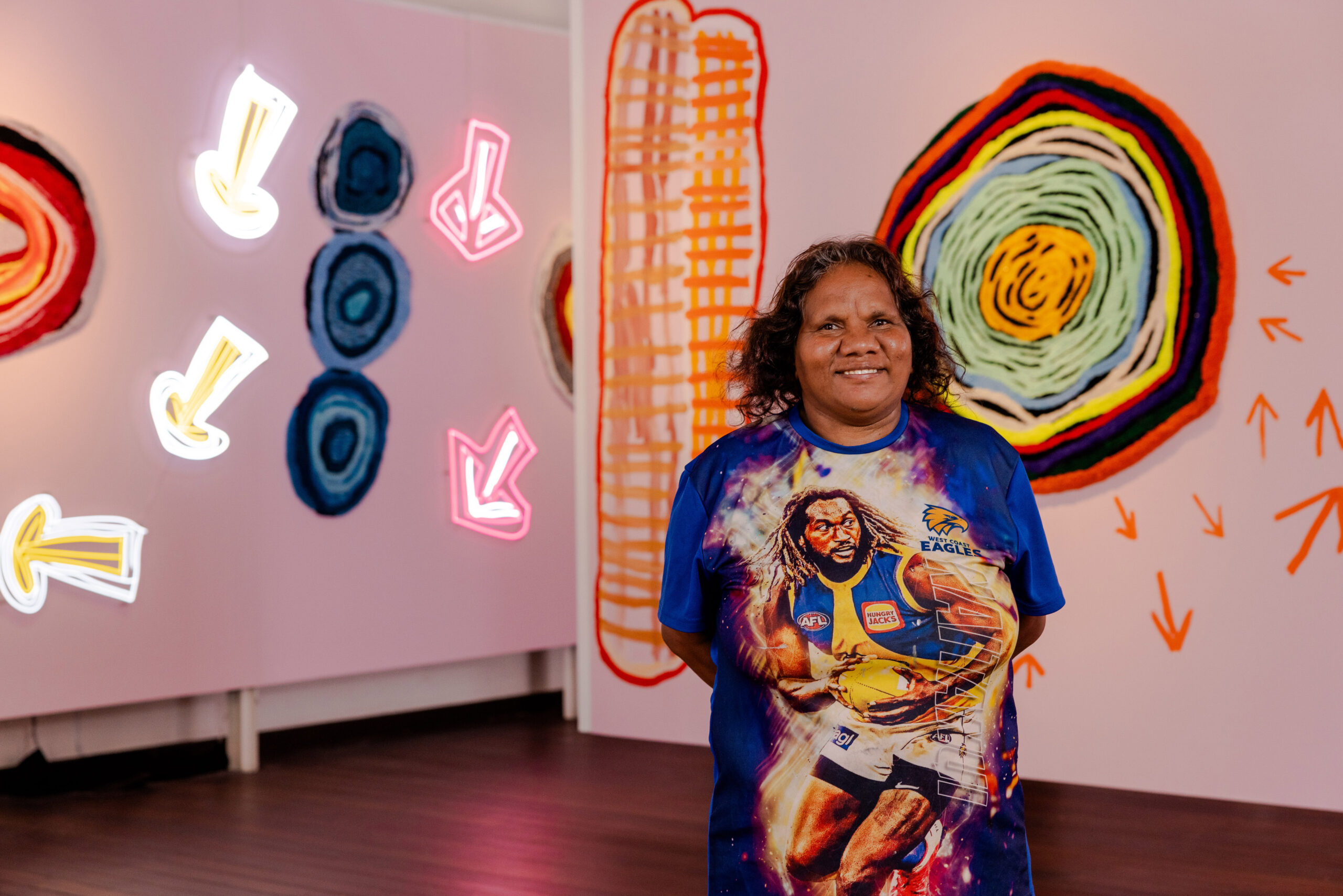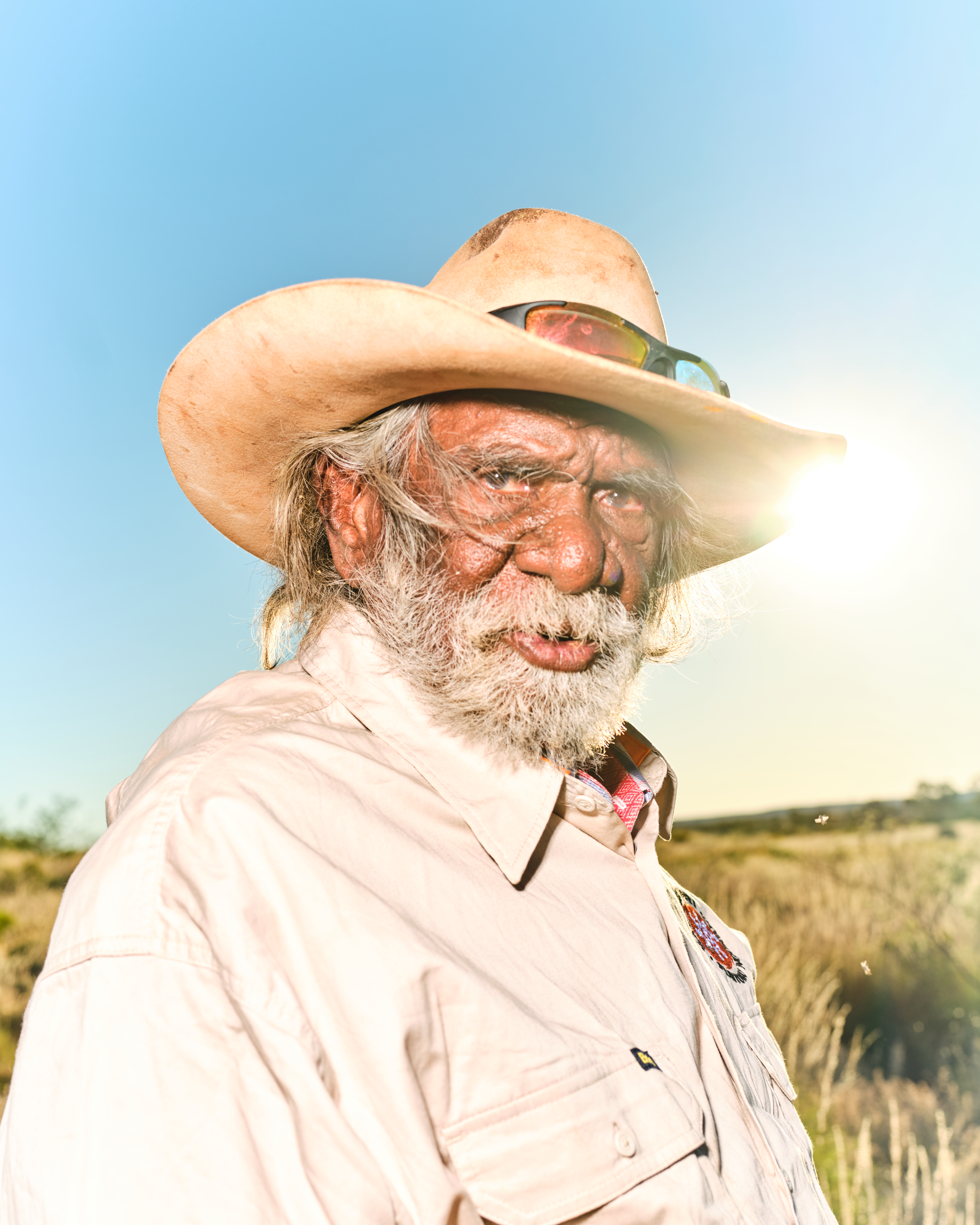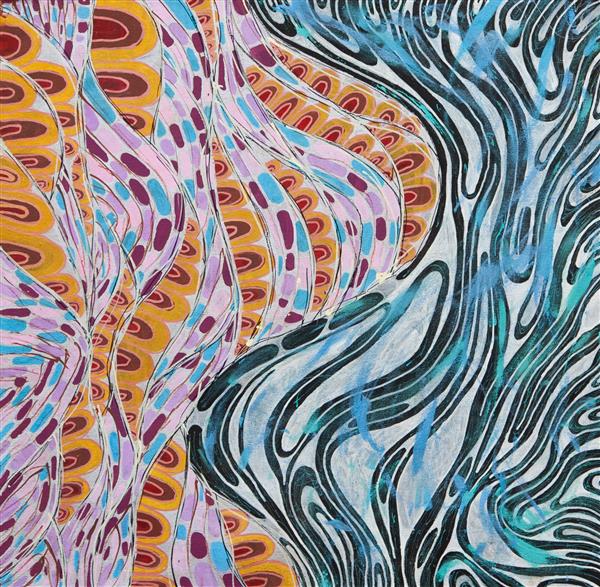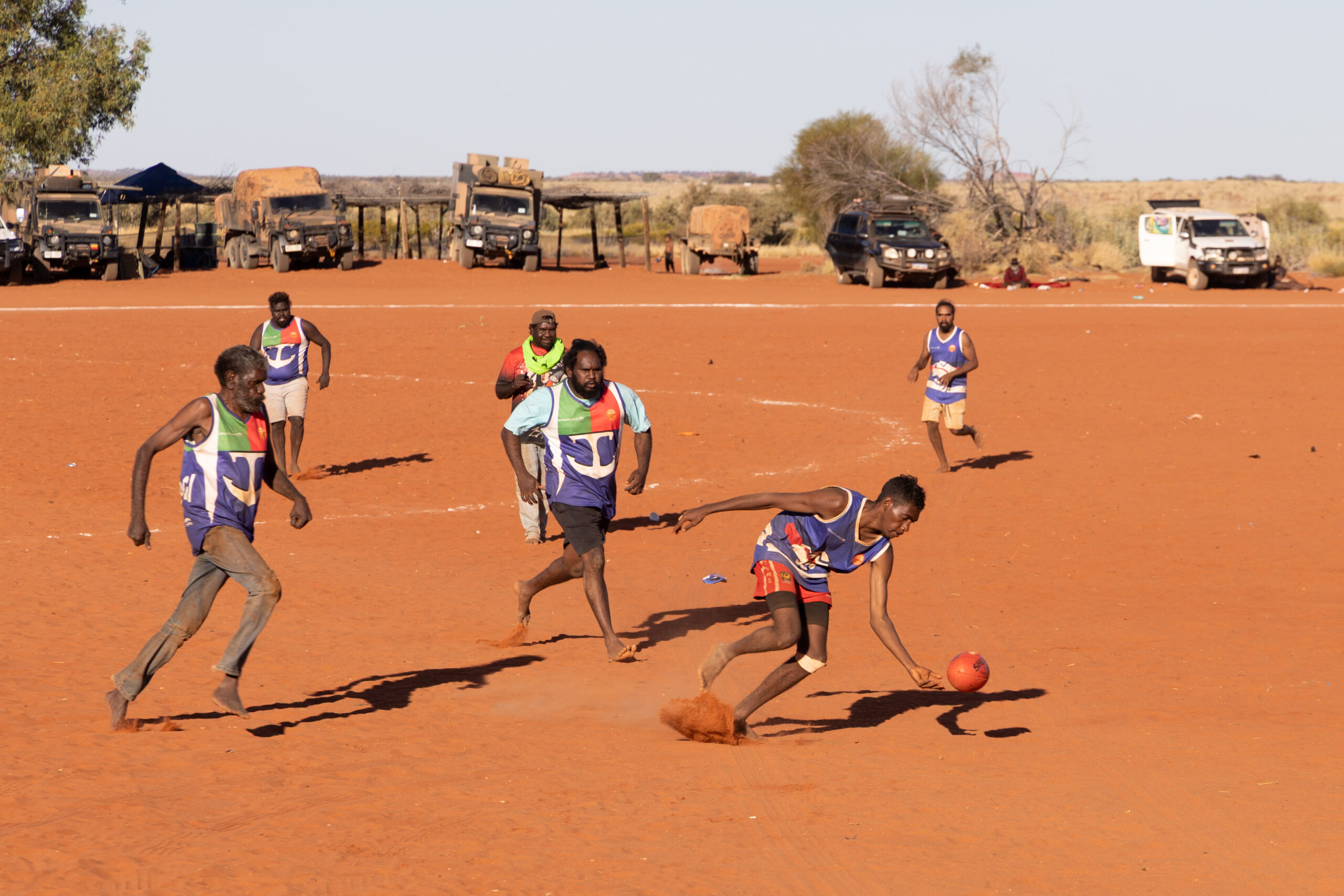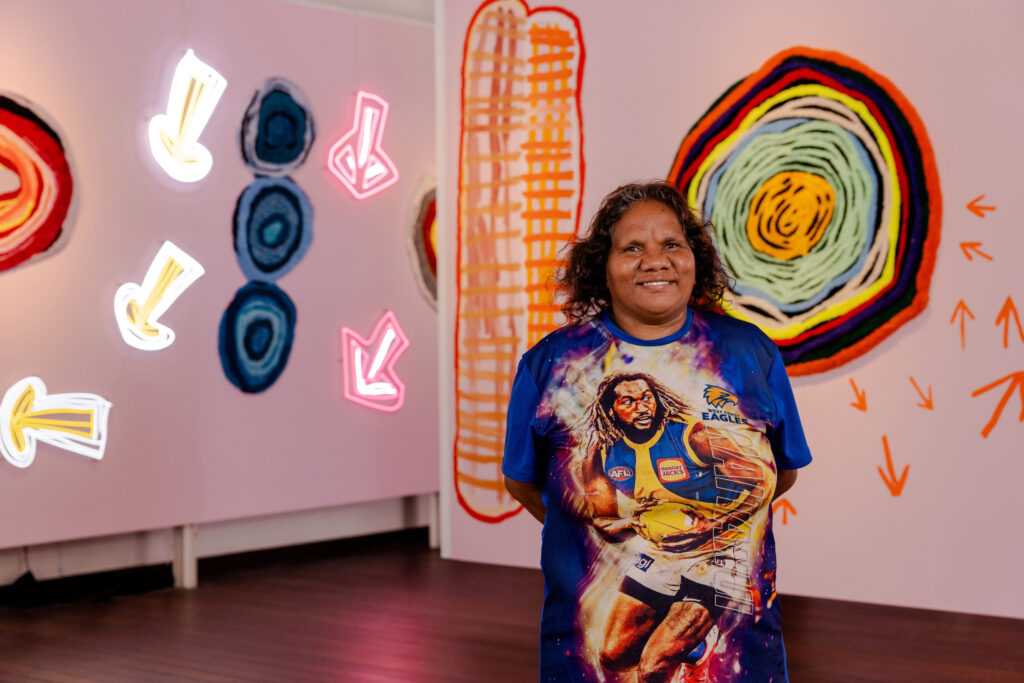
A few years ago, I ran an ‘artist dreams’ workshop, where participants pitched their hypothetical big vision project. Martu artist Judith Anya Samson said she wanted to create a whole world out of her paintings – Anya’s World – where audiences could step inside her artwork and explore the different painterly elements that form her unique contemporary wayfinding. Fusing jukurrpa (Dreaming), Country and colonial history, Anya’s world is a multilayered version of remote life in the Pilbara; a major mining region, alongside an ancestral story of custodianship.
Anya is a mid-career Martu artist who was raised by her grandma and spent much time travelling to her ancestral Country around the Rabbit Proof Fence areas, near Jigalong. In the unique aesthetic of her grandmother, her gestural and seemingly abstract style is a series of codes and symbols relating to thousands of years of knowledge and the lived colonial experience the Western Desert.
“I was still a young girl, still crawling in the desert. It was nice there. Some other families lived there with us. We had some farm, some vegetables. We went schooling in Puntawarri at the school, learning ‘two way’ [refers to teaching in both Martu Wangka and English, with a focus on local cultural and ecological knowledge]. We used to go and get some parnajarrpa (goanna) and turkey.”
– Judith Anya Samson courtesy of Martumili Artists.

Born in 1988, she moved to Jigalong as a young girl and later moved to Newman for high school. She began painting early in life, and then later went on to work at Martumili Artists as staff, also regularly joining Kanyirninpa Jukurrpa on ranger programs. For over 20 years, Anya’s joy and dedication has been backbone to the Martumili studio, moving seamlessly between making her own artwork and helping others.
For many Martu including Anya’s family, Jigalong Mission was the site where traditional desert life came to an end and the transition to life in a cattle station begun. Now more recently, the colonial expansion of mining in the region adds another complexity to life, on top of 60,000 years of living history. Anya’s work touches all these layers with a jovial demeanour, yet her work is loaded with magical and political symbols. She has a unique ability to hold so much knowledge and responsibility whilst creating such joy on canvas.
Through this work, Anya opens her heart – a generosity that feels palpable in the gallery, in the way that it envelopes audiences through an immersive depiction of ‘Anya’s World’.
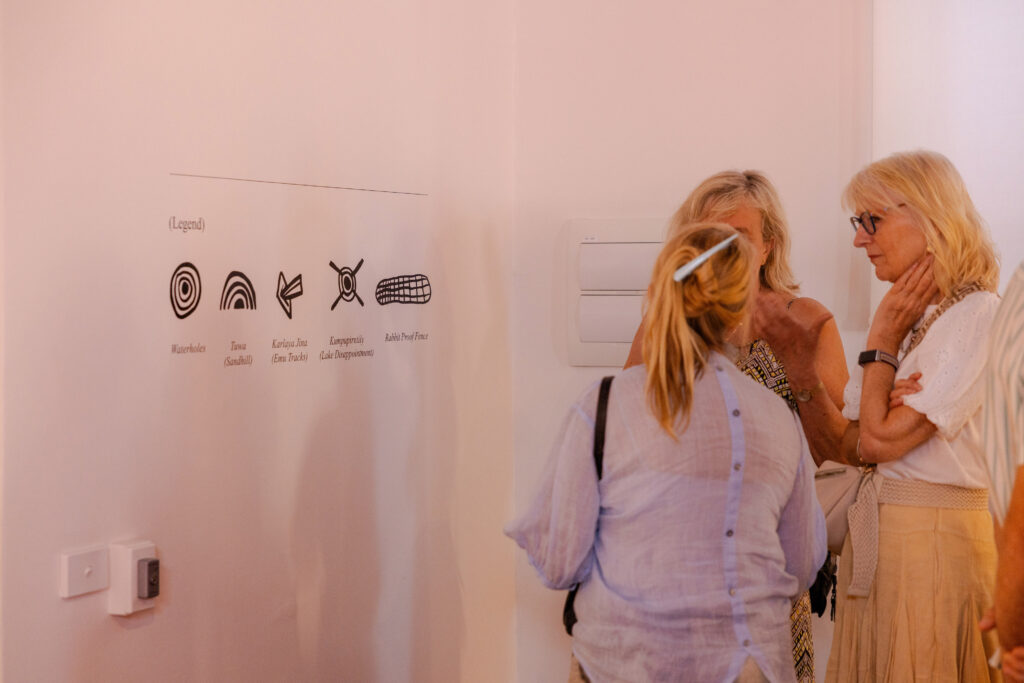
Anya’s Wayfinding
Tuwa (Sandhill)
“I do tuwa (sandhill) in my own style because that’s our Country. That’s a sandhill, that’s the Dreaming – the Jukurrpa. That’s our culture.”
– Judith Anya Samson courtesy of Martumili Artists.
These rainbow-like shapes are the sandhills that form the country around Jigalong. Martu lands of the Great Sandy Desert and Rudall River Regions of WA encompasses enormous tracts of distinctive sandhills.
Puntawarri
Puntawarri is an important cultural area located east of Jigalong in the middle of canning stock route; a place with 60,000 years of jukurrpa (Dreaming) lore and history. Usually depicted as a series of shapes, Puntawarri is also the site of an abandoned community, waterhole, lake and creek. These important water sites made it a popular site for Martu to visit during the ‘mission days’ to connect with Country and traditional ways of life. Anya’s grandmother would have visited frequently with her and ensured a connection between that site and her artwork.
Emu Tracks (Karlaya Jina)
“Emu go to the springs to have a drink of water and then move on to the
next one.”
– Judith Anya Samson courtesy of Martumili Artists.
As mentioned, Puntawarri is a special site due to the series of natural water sources and therefore would have been plentiful for emu’s. Synonymous with Anya’s practice is the emu track; the arrow shapes in her work that are full of movement and life. Before colonisation, Martu would have tracked the emu from water source to water source as a source of food. Locating and tracking would have involved following the arrow like tracks in the sand.
Kumpupirntily (Lake Disappointment)
“The cannibals live underneath the lake there. It’s a salt lake. That’s our Country.”
– Judith Anya Samson courtesy of Martumili Artists.
Located in the Little Sandy and Gibson Desert of WA, Kumpupirntily is one of the most sacred and dangerous places in the desert as the Ngayurnangalku (cannibal people) have made the lake their home, hiding in the subterranean world, lit by their own sun.
Rabbit Proof Fence
“We still see that Rabbit Proof Fence out there, it goes to Jilakurru then to Jigalong, long one, and it’s a bit broken now. The three girls passed through Jilakurru going to Jigalong. Everybody likes that story in Jigalong, I like painting that story.”
– Judith Anya Samson courtesy of Martumili Artists.
In 1931 sisters Molly Craig, Daisy Kadibil and Gracie Fields were taken from their families, like many other Aboriginal children at that time, and transported to Moore River Native Settlement, north of Perth. They were taken away in the belief that part Aboriginal children should be trained as domestic servants. The three girls escaped the next day and, incredibly, walked 1,600 kilometres home to Jigalong using the Rabbit Proof Fence to navigate. The Rabbit Proof Fence remains the world’s longest fence, and was built in the early 1900s to separate rabbits from pasture. For nine weeks, the girls followed its length to be reunited with their family. For the duration of their journey they were pursued by policeman and an Aboriginal police tracker.
Waterholes
The concentric circles in Anya’s work often features with emu tracks and sandhills from the water holes or water sources that were intrinsic to the survival of Martu and hunting activities. They are places are maintained for their freshness and vitality, featuring as map markers in many desert paintings.
Text collaboration between Martumili Artists and Emilia Galatis.
Photography by Danica Zuks.
